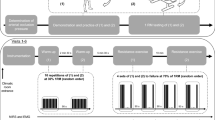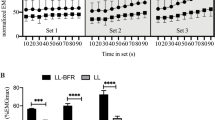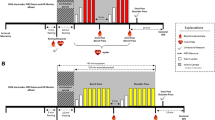Abstract
Background and objectives
Isometric resistance training combined with blood flow obstruction can improve the effects of blood flow obstruction training. The present research aimed to evaluate the effect of one session of isometric resistance activity under local and systemic hypoxia and normoxia conditions on fatigue and muscle function in trained men.
Methods
A total of 12 healthy students with the history of resistance training (mean age of 24.9 ± 0.23 years, height of 179.6 ± 1.99 cm, and weight of 74.4 ± 2.7 kg) participated in this quasi-experimental study voluntarily. The protocol of this study consisted of six 10-s isometric contractions and the subjects rested for 60 s between each two contractions. It was repeated exactly 1 week apart between the two sessions in three sessions of activity with 30% of maximum voluntary contraction (MVC) under systemic hypoxia conditions (in hypoxia tent equivalent to 3300 m elevation), 30% of MVC under local hypoxia conditions (blood flow restriction by closing the blood pressure cuff) and 30% of MVC under normoxia conditions. Integrated electromyography (IEMG) was used to determine muscle function, and enzyme-linked immunosorbent assay (ELISA) was used to measure blood lactate concentration. The repeated measures analysis of variance and Bonferroni post hoc test were used to analyze data. A P value less than 0.05 was considered to be statistically significant in this study.
Results
IEMG index and blood lactate concentration were significantly higher than normal (P < 0.05) following resistance activity under systemic and local hypoxia conditions. Moreover, no significant difference was observed in the IEMG and blood lactate values between systemic and local hypoxia (P > 0.05).
Conclusion
From the results it can be concluded that performing isometric resistance activity with blood flow obstruction can exert further pressure on the muscle compared to performing the same activity with equal load, but without blood flow obstruction.






Similar content being viewed by others
References
American College of Sports Medicine (2009) American College of Sports Medicine position stand. Progression models in resistance training for healthy adults. Med Sci Sports Exerc 41(3):687–708. https://doi.org/10.1249/mss.0b013e3181915670
Tayebi SM et al (2019) Plasma retinol-binding protein-4 and tumor necrosis factor-α are reduced in postmenopausal women after combination of different intensities of circuit resistance training and Zataria supplementation. Sport Sci Health 15(3):551–558. https://doi.org/10.1007/s11332-019-00544-2
Cook SB, Cleary CJ (2019) Progression of blood flow restricted resistance training in older adults at risk of mobility limitations. Front Physiol 10:738. https://doi.org/10.3389/fphys.2019.00738
Pereira-Neto EA, Lewthwaite H, Boyle T, Johnston K, Bennett H, Williams MT (2021) Effects of exercise training with blood flow restriction on vascular function in adults: a systematic review and meta-analysis. PeerJ 9:e11554. https://doi.org/10.7717/peerj.11554
Cerqueira MS, Do Nascimento JDS, Maciel DG, Barboza JAM, De Brito Vieira WH (2020) Effects of blood flow restriction without additional exercise on strength reductions and muscular atrophy following immobilization: a systematic review: passive blood flow restriction and disuse. J Sport Heal Sci 9(2):152–159. https://doi.org/10.1016/j.jshs.2019.07.001
Centner C, Wiegel P, Gollhofer A, König D (2019) Effects of blood flow restriction training on muscular strength and hypertrophy in older individuals: a systematic review and meta-analysis. Sport Med 49(1):95–108. https://doi.org/10.1007/s40279-018-0994-1
Lauber B, König D, Gollhofer A, Centner C (2021) Isometric blood flow restriction exercise: acute physiological and neuromuscular responses. BMC Sports Sci Med Rehabil 13(1):12. https://doi.org/10.1186/s13102-021-00239-7
Patterson SD, Hughes L, Warmington S, Burr J, Scott BR, Owens J et al (2019) Blood flow restriction exercise position stand: Considerations of methodology, application, and safety. Front Physiol 10:533. https://doi.org/10.3389/fphys.2019.00533
Takarada Y, Nakamura Y, Aruga S, Onda T, Miyazaki S, Ishii N (2000) Rapid increase in plasma growth hormone after low-intensity resistance exercise with vascular occlusion. J Appl Physiol 88(1):61–65. https://doi.org/10.1152/jappl.2000.88.1.61
Pope ZK, Willardson JM, Schoenfeld BJ (2013) Exercise and Blood Flow Restriction. J Strength Cond Res 27(10):2914–2926. https://doi.org/10.1519/jsc.0b013e3182874721
Suga T, Okita K, Morita N, Yokota T, Hirabayashi K, Horiuchi M et al (2009) Intramuscular metabolism during low-intensity resistance exercise with blood flow restriction. J Appl Physiol 106(4):1119–1124. https://doi.org/10.1152/japplphysiol.90368.2008
Fujita S, Abe T, Drummond MJ, Cadenas JG, Dreyer HC, Sato Y et al (2007) Blood flow restriction during low-intensity resistance exercise increases S6K1 phosphorylation and muscle protein synthesis. J Appl Physiol 103(3):903–910. https://doi.org/10.1152/japplphysiol.00195.2007
Shirvani H, Aslani J (2017) The effects of high-intensity interval training vs. moderate-intensity continuous training on serum irisin and expression of skeletal muscle PGC-1α gene in male rats. Tehran Univ Med J 75(7). http://tumj.tums.ac.ir/article-1-8337-en.html.
Russo AF, Dickerson I (2006) CGRP: a multifunctional neuropeptide. In: Lajtha A, Lim R (eds) Handbook of neurochemistry and molecular neurobiology, 3rd edn. Springer, Boston, pp 391–426. https://doi.org/10.1007/978-0-387-30381-9_19
Shirvani H, Rostamkhani F (2020) Exercise considerations during coronavirus disease 2019 (COVID-19) outbreak: a narrative review. J Military Med. https://doi.org/10.30491/JMM.22.2.161
Kamen G, Gabriel DA (2010) Essentials of electromyography. Human Kinetics, Leeds
Yasuda T, Fujita T, Miyagi Y, Kubota Y, Sato Y, Nakajima T et al (2006) Electromyographic responses of arm and chest muscle during bench press exercise with and without KAATSU. Int J KAATSU Train Res 2(1):15–18. https://doi.org/10.3806/ijktr.2.15
Lambert B, Hedt C, Daum J, Taft C, Chaliki K, Epner E et al (2021) Blood flow restriction training for the shoulder: a case for proximal benefit. Am J Sports Med 49(10):2716–2728. https://doi.org/10.1177/03635465211017524
Yasuda T, Fukumura K, Fukuda T, Iida H, Imuta H, Sato Y et al (2014) Effects of low-intensity, elastic band resistance exercise combined with blood flow restriction on muscle activation. Scand J Med Sci Sport 24(1):55–61. https://doi.org/10.1111/j.1600-0838.2012.01489.x
Nam SS, Park HY (2020) Effects of endurance exercise under hypoxia on acid-base and ion balance in healthy males. Phys Act Nutr 24(3):7–12. https://doi.org/10.20463/pan.2020.0015
Suga T, Okita K, Takada S, Omokawa M, Kadoguchi T, Yokota T et al (2012) Effect of multiple set on intramuscular metabolic stress during low-intensity resistance exercise with blood flow restriction. Eur J Appl Physiol 112(11):3915–3920. https://doi.org/10.1007/s00421-012-2377-x
Corvino RB, Rossiter HB, Loch T, Martins JC, Caputo F (2017) Physiological responses to interval endurance exercise at different levels of blood flow restriction. Eur J Appl Physiol 117(1):39–52. https://doi.org/10.1007/s00421-016-3497-5
Scott BR, Slattery KM, Sculley DV, Dascombe BJ (2014) Hypoxia and resistance exercise: a comparison of localized and systemic methods. Sport Med 44(8):1037–1054. https://doi.org/10.1007/s40279-014-0177-7
Nishimura A, Sugita M, Kato K, Fukuda A, Sudo A, Uchida A (2010) Hypoxia increases muscle hypertrophy induced by resistance training. Int J Sports Physiol Perform 5(4):497–508. https://doi.org/10.1123/ijspp.5.4.497
Nakajima T, Morita T, Sato Y (2011) Key considerations when conducting KAATSU training. Int J KAATSU Train Res 7(1):1–6. https://doi.org/10.3806/ijktr.7.1
Council for International Organizations of Medical Sciences (CIOMS) (2016) International ethical guidelines for health-related research involving humans. Fourth Edition. CIOMS, Geneva, Switzerland. https://cioms.ch/wp-content/uploads/2017/01/WEB-CIOMS-EthicalGuidelines.pdf
Yasuda T, Brechue WF, Fujita T, Sato Y, Abe T (2008) Muscle activation during low-intensity muscle contractions with varying levels of external limb compression. J Sport Sci Med 7(4):467–474
Wernbom M, Järrebring R, Andreasson M, Augustsson J (2009) Acute effects of blood flow restriction on muscle activity and endurance during fatiguing dynamic knee extensions at low load. J Strength Cond Res 23(8):2389–2395. https://doi.org/10.1519/jsc.0b013e3181bc1c2a
Loenneke JP, Fahs CA, Rossow LM, Sherk VD, Thiebaud RS, Abe T et al (2012) Effects of cuff width on arterial occlusion: Implications for blood flow restricted exercise. Eur J Appl Physiol 112(8):2903–2912. https://doi.org/10.1007/s00421-011-2266-8
Yasuda T, Brechue W, Fujita T, Shirakawa J, Sato Y, Abe T (2009) Muscle activation during low-intensity muscle contractions with restricted blood flow. J Sports Sci 27(5):479–489. https://doi.org/10.1080/02640410802626567
Yasuda T, Loenneke J, Ogasawara R, Abe T (2013) Influence of continuous or intermittent blood flow restriction on muscle activation during low-intensity multiple sets of resistance exercise. Acta Physiol Hung 100(4):419–426. https://doi.org/10.1556/aphysiol.100.2013.4.6
Fukuda T, Yasuda T, Fukumura K, Iida H, Morita T, Sato Y et al (2013) Low-intensity kaatsu resistance exercises using an elastic band enhance muscle activation in patients with cardiovascular diseases. Int J KAATSU Train Res 9(1):1–5. https://doi.org/10.3806/ijktr.9.1
Manimmanakorn A, Manimmanakorn N, Taylor R, Nick D, Billaut F, Shearman J et al (2013) Effects of resistance training combined with vascular occlusion or hypoxia on neuromuscular function in athletes. Eur J Appl Physiol 113(7):1767–1774. https://doi.org/10.1007/s00421-013-2605-z
Takarada Y, Takazawa H, Sato Y, Takebayashi S, Tanaka Y, Ishii N (2000) Effects of resistance exercise combined with moderate vascular occlusion on muscular function in humans. J Appl Physiol 88(6):2097–2106. https://doi.org/10.1152/jappl.2000.88.6.2097
Loenneke JP, Fahs CA, Wilson JM, Bemben MG (2011) Blood flow restriction: the metabolite/volume threshold theory. Med Hypotheses 77(5):748–752. https://doi.org/10.1016/j.mehy.2011.07.029
Shirvani H, Aslani J, Fallah Mohammadi Z et al (2019) Short-term effect of low-, moderate-, and high-intensity exercise training on cerebral dopamine neurotrophic factor (CDNF) and oxidative stress biomarkers in brain male Wistar rats. Comp Clin Pathol 28:369–376. https://doi.org/10.1007/s00580-018-2885-0
Yasuda T, Abe T, Brechue WF, Iida H, Takano H, Meguro K et al (2010) Venous blood gas and metabolite response to low-intensity muscle contractions with external limb compression. Metabolism 59(10):1510–1519. https://doi.org/10.1016/j.metabol.2010.01.016
Karabulut M, Cramer JT, Ryan ED, Anderson RL, Hull HR, Sato Y et al (2006) Effects of KAATSU on muscular function during isometric exercise. Int J KAATSU Train Res 2(2):19–28. https://doi.org/10.3806/ijktr.2.19
Takano H, Morita T, Iida H, Asada K-I, Kato M, Uno K et al (2005) Hemodynamic and hormonal responses to a short-term low-intensity resistance exercise with the reduction of muscle blood flow. Eur J Appl Physiol 95(1):65–73. https://doi.org/10.1007/s00421-005-1389-1
Ilett MJ, Rantalainen T, Keske MA, May AK, Warmington SA (2019) The effects of restriction pressures on the acute responses to blood flow restriction exercise. Front Physiol 10:1018. https://doi.org/10.3389/fphys.2019.01018
Cook SB, Clark BC, Ploutz-Snyder LL (2007) Effects of exercise load and blood-flow restriction on skeletal muscle function. Med Sci Sports Exerc 39(10):1708–1713. https://doi.org/10.1249/mss.0b013e31812383d6
Reeves GV, Kraemer RR, Hollander DB, Clavier J, Thomas C, Francois M et al (2006) Comparison of hormone responses following light resistance exercise with partial vascular occlusion and moderately difficult resistance exercise without occlusion. J Appl Physiol 101(6):1616–1622. https://doi.org/10.1152/japplphysiol.00440.2006
Perez GE, Lopez JOEA, Karabulut M (2013) Gender comparisons of the electromyographic responses to knee extension exercises with different initial restriction pressures. TACSM abstract. Int J Exerc Sci. https://digitalcommons.wku.edu/cgi/viewcontent.cgi?article=1561&context=ijesab
Acknowledgements
We hereby sincerely thank all the individuals who collaborated in the present study.
Author information
Authors and Affiliations
Corresponding author
Ethics declarations
Conflict of interest
There was no conflict of interest in conducting this study.
Ethical approval
The whole training protocol was implemented in this study based on international ethical instructions for biomedical studies on human participants provided by the Council for International Organizations of Medical Sciences (CIOMS) in cooperation with the World Health Organization (WHO) in 2016 in Geneva. All procedures performed in studies involving human participants were in accordance with the ethical standards of the institutional and/or national research committee and with the 1964 Helsinki declaration and its later amendments or comparable ethical standards.
Informed consent
Informed consent was obtained from the patient included in the case report.
Additional information
Publisher's Note
Springer Nature remains neutral with regard to jurisdictional claims in published maps and institutional affiliations.
Rights and permissions
About this article
Cite this article
Aghaei, F., Shadmehri, S., Feizollahi, F. et al. Short-term effects of isometric exercise with local and systemic hypoxia and normoxia on fatigue and muscle function in trained men. Sport Sci Health 19, 553–563 (2023). https://doi.org/10.1007/s11332-022-00917-0
Received:
Accepted:
Published:
Issue Date:
DOI: https://doi.org/10.1007/s11332-022-00917-0




